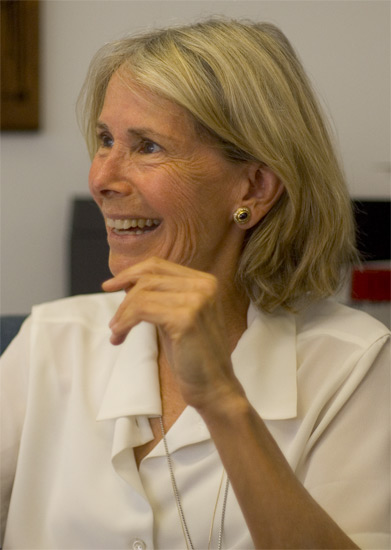
The novel Don Quixote by Miquel de Cervantes is still the most widely read masterpiece in world literature, as popular today as it was in the 1600s. BMCC’s Fay Rogg recently co-wrote Fighting Windmills: Encounters with Don Quixote (Yale University Press) with Miquel Durán, a former professor at Yale, where she received her Masters and Ph.D in Spanish and Latin American Language and Literature, with a minor in French. The project was sparked by a conversation with Harold Bloom, the prominent literary and cultural critic.
“I ran into Harold at the Yale club. I asked him who his favorite author is. He said, ‘I’d have to say Shakespeare, Fay. And what about you?’ I told him it was Cervantes, without a doubt. He went on, saying, ‘But that’s one book. He wrote one book.’ Yes, I told him. But everything is in that one book. Everyone is in it. I mentioned my former professor, Manolo Durán, an expert on the topic, and as fate would have it, I ended up writing a book with him.”
Rogg’s mission was to make the writing in Fighting Windmills very accessible, so as to reach out to a general audience — people much like her students at BMCC. In this effort, she succeeded: the language is not academic, but a rather direct, straight-narrative prose. With a panoramic lens, the book manages to probe into Cervantes’s own life, the effects of it on his work, and the influence Don Quixote has had on generations of writers.
“Tilting at Windmills’ is really the proper phrase, not ‘Fighting Windmills,’” explains Rogg. “Don Quixote really thought they were giants he was fighting, and when he realized what they really were, he insisted that enchanters had turned them into windmills. Not for a second would he admit to being out of his mind.” Rogg argues that most of us are flawed heroes of the stories we live, much like Don Quixote—at least those of us trying to right the wrongs of the world despite all signs of futility.
“We know we won’t win but in spite of that fact, we continue to fight,” Rogg explains. “Maybe it’s the only way to be truly alive. Regardless, I think this school especially should have an entire class devoted to this novel. It should be required reading for all faculty members too, not just the students.”
Fay Rogg’s passion for the novel Don Quixote jumps off the pages of Fighting Windmills. Both authors credit Cervantes as the first modern novelist and go beyond the story to investigate the techniques Cervantes used as his narrative tools in recreating the modern form of the novel.
“We then romp through the centuries of literature,” Rogg says, referring to the later sections of the book. “We cover French, English, Russian, Spanish and American novels to see how Cervantes influenced a diverse list of modernists writers that include Borges, Dostoyevsky, Graham Greene, F. Scott Fitzgerald — even Woody Allen.”
And that’s precisely what Fay Rogg and Manuel Durán manage to do, in a conversational yet knowledgeable way, a description also befitting Rogg’s teaching style at BMCC.
Fay Rogg joined the faculty at BMCC in 1968, after receiving her Masters and Ph.D from Yale University. Born to Eastern European immigrant Jews in Timmins, Ontario, she was raised in Montreal, Canada, where she received her undergraduate degree from McGill University. She’s served as chair of BMCC’s Modern Languages department for ten years, after serving as Deputy Chair for five.
Soon after receiving her Ph.D, Rogg was offered teaching posts at both City College and New York University, but she took the job at BMCC. In addition to pursuing her own creative writing projects and writing reviews of new Latin American authors for the Center for Inter-American Relations, Rogg has steadily worked towards developing the curriculum in the area of foreign languages for 38 years. Her department now boasts a full list of concentrations: French, Spanish, Italian and Chinese.
“I like the students here,” Fay explains. “In Canada we have diversity but not like what you find at BMCC. I was head of the Foreign Languages department at McGill when I was 23, but I knew right away that that wasn’t enough.
At BMCC she found potential untapped. In trying to improve upon what was being offered to students, she sought the powers that be in Albany and gathered the funding to start The Learning Center (TLC), which was initially called the Career Learning Resource Center.
“I realized many of the kids needed tutoring to get on the college track,” Rogg remembers. “The state only gave money for what they saw as career-oriented projects. Back then this meant classes related to business, accounting or data processing,” She laughs at the outdated model for community colleges then and remembers the late ’60s. “And there was so much strife here on campus. It was the late ’60s, after all. I had a Black Panther in one of my classes. He was a very intelligent and kind student, but he scared the wits out of me at first!”
Despite the changing politics and the limited funding for more academic programs, Rogg trudged on. From 1971 to 1972, CUNY’s chancellor sent her to survey a range of core curricula across the country and Canada. This project is one Fay will always be proud of, as it gave firm numbers and statistics to her intuitive sense of what the school needed. In addition to getting more funding from the state, she also began reaching out to the private sector for invaluable grants to aid in the College’s growth.
“For me, teaching at that point was secondary to giving credibility to the school,” Fay explains. “But I feel I’ve done what I have to do in terms of helping to build the foundation here. Now that it’s strong, I want to focus on improving the students’ basics of Spanish. I’m finally interested in pedagogy again.”

